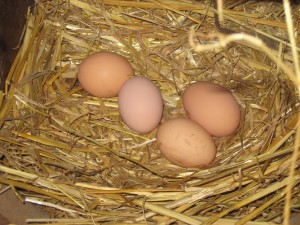Our egg came from Rowan and Freddie's house. This is what it looked like in the nest.

Students in BC, Manitoba and Newfoundland will ALL be conducting the same experiment. We will see if eggs are the same all across Canada.
View Egg Experiment in a larger map
We are going to be conducting an experiment in the Grade 1/2 class. Students are learning about living things – what they need, how they grow, and how they change. Students are often given the opportunity to observe living things up close in the classroom, from insects to chicks. But what if things are growing that we can't see, such as seeds or chrysalises or eggs?
Here's a science exploration that we will do with a real chicken egg. Using vinegar,we will make the egg's shell see-through, and observe what's going on inside!
What We Need:
* 1 raw chicken egg in its shell (one from the grocery store is fine)
* White vinegar
* Clear glass jar with a cover
* Turkey baster
What to Do:
1. Carefully place the whole, uncooked egg in the glass jar. Use a big spoon if necessary.
2. Pour vinegar over the egg so that it is completely submersed in the vinegar.
3. Cover the jar and observe. We will discuss: what is happening inside the jar? What can she see? (She should see bubbles forming.) What will they think might be happening?
4. The bubbles we see in the jar tell you that the vinegar is dissolving the eggshell. It’s eating away at the “stuff” (calcium, mostly) that makes egg shells hard.
5. Place the jar inside the refrigerator for about 24 hours. Take it out of the fridge, and use a baster to remove most of the vinegar. (Be careful not to poke or bump the egg! Remember, its shell has been dissolving.) Then pour fresh vinegar over the egg, and return to the refrigerator for another 24 hours.
6. Continue in this manner until the eggshell becomes see-through. (The amount of time needed to achieve this varies with the size, variety, and thickness of the eggshell.)
7. Gently use a large spoon to scoop out the egg. Now you have an egg without a shell! We will see the insides of the egg, which are being held inside by a membrane. Explain that the membrane is like a skin around the egg. Why is this membrane needed? (It keeps out dirt and germs and other harmful substances. It also lets air get in.)
8. We will observe the shell-less egg and describe what we see. We will name the parts of the egg? (Yolk, egg white or albumen, etc.)
9. Finally, we will hold the egg in our hands over a sink and give a very gentle squeeze. (Watch out! If you squeeze too hard, the egg will explode!) We will discuss what does it feel like? (It feels like a squishy pillow.) Discuss why the insides of the egg would be a perfect place for a baby chick to grow before it hatches. (It’s squishy, so it’s like a cushion for the growing chick, and the membrane and shell keep it safe.)
Liana Mahoney is a National Board Certified elementary teacher, currently teaching a first and second grade loop. She is also a certified Reading Specialist, with teaching experience as a former high school English teacher, and early grades Remedial Reading Instructor.
link to website

Hi Grade Ones and Twos!
We are ready to Skype with you later this afternoon. We started our experiment this morning. We will tell you all about it this afternoon when we chat for the first time.
Love,
Your Winnipeg Grade 1 Friends